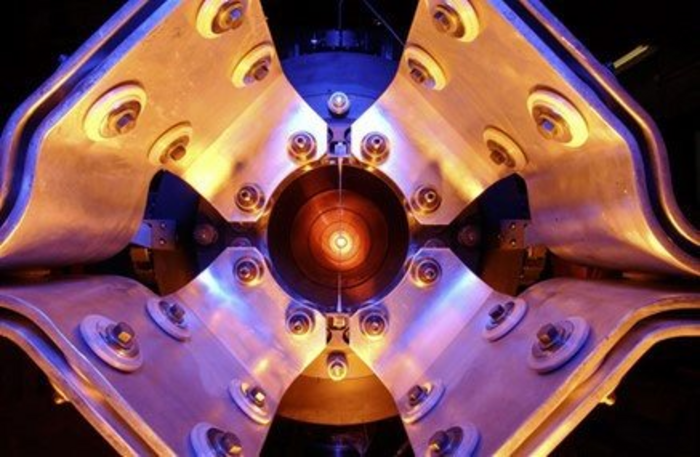Protons and neutrons, the building blocks of atomic nuclei, are themselves made up of strongly interacting quarks and gluons”>quarks and gluons. Because the interactions are so strong, the structure of protons and neutrons is difficult to calculate from theory. Instead, scientists must measure it experimentally. Neutrino experiments use targets that are nuclei made of many protons and neutrons bound together. This complicates interpreting those measurements to infer proton structure. By scattering neutrinos from the protons that are the nuclei of hydrogen atoms in the MINERvA detector, scientists have provided the first measurements of this structure with neutrinos using unbound protons.

Credit: Image by Reidar Hahn, Fermi National Accelerator Laboratory.
The Science
Protons and neutrons, the building blocks of atomic nuclei, are themselves made up of strongly interacting quarks and gluons”>quarks and gluons. Because the interactions are so strong, the structure of protons and neutrons is difficult to calculate from theory. Instead, scientists must measure it experimentally. Neutrino experiments use targets that are nuclei made of many protons and neutrons bound together. This complicates interpreting those measurements to infer proton structure. By scattering neutrinos from the protons that are the nuclei of hydrogen atoms in the MINERvA detector, scientists have provided the first measurements of this structure with neutrinos using unbound protons.
The Impact
Researchers are building several large neutrion experiments, including DUNE and the Sanford Underground Research Facility. These experiments will help make precise measurements of neutrino properties. This in turn will answer questions about how neutrinos affected the structure of our Universe. Those experiments require an accurate understanding of how neutrinos interact on the heavy nuclei in the experiments, such as argon in the case of DUNE. Building a theory of those interactions requires separating the effects of neutrino scattering from protons or neutrons and the effects of the binding in the nucleus. By measuring this property of free protons, the results from MINERvA will help to build more complete theories of neutrino interactions.
Summary
The primary challenge in the measurement described in this new research is that the hydrogen in MINERvA’s detector is chemically mixed half and half in plastic with carbon atoms. There are six protons in the carbon atom, so the carbon background reaction is much larger. By developing a novel technique to measure the direction of the outgoing neutron in the reaction, anti-muon neutrino on proton creates anti-muon and neutron, researchers can separate the two reaction types. This allows study of the residual backgrounds using the same parallel reaction in a neutrino beam, where no reaction on the hydrogen atoms is possible. This measurement of structure is interpreted as the axial vector form factor of the proton, a technical term for the structure revealed by neutrino scattering, so that it can be used as inputs to predictions of neutrino reactions.
Funding
This work was funded by the Department of Energy Office of Science, Office of High Energy Physics, by the University of Rochester’s Messersmith Graduate Fellowships, and by the National Science Foundation’s Graduate Research Fellowships. The Fermilab Accelerator Complex that creates the NuMI neutrino beam used for MINERvA and other experiments is a DOE Office of Science user facility.
Journal
Nature
DOI
10.1038/s41586-022-05478-3
Method of Research
Experimental study
Subject of Research
Not applicable
Article Title
Measurement of the axial vector form factor from antineutrino–proton scattering
Article Publication Date
1-Feb-2023




